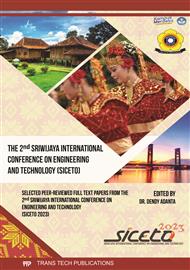p.3
p.13
p.25
p.39
p.49
p.59
p.67
Analysis of the Bearing Capacity of Group Pile Foundations with the Vesic Method
Abstract:
This study focuses experimentally on the bearing capacity of group pile foundations used in the Palembang Health Polytechnic Dental Nursing Lecture Building, considering that this type of foundation is able to support a large enough load. To determine the efficiency of the bearing capacity of pile foundations, calculations were made based on N-SPT data using the Vesic 1977 method and exsisting. The study was conducted at the PC-9A point at the Palembang Health Polytechnic Dental Nursing Building using variations in diameter Ø30, Ø40, Ø50, Ø60, 35 x 35, 40 x 40, and 45 x 45 at depths of 11, 12, 13, 14, 15, 16 m, with a fixed concrete quality of K-500. The results of the calculation of the bearing capacity of the group pile found ation, on PC-9A in Vesic 1977 amounted to 2761.576 kN and used vesic 1977 amounted to 2763.28 kN with a difference of 23%. The largest foundation bearing capacity is located at 40 x 40 dimensions with a bearing capacity of 3698.97 kN, while the smallest foundation bearing capacity is located at 30 diameters with a bearing capacity of 2784.84 kN. The results of the calculation of variations on the efficient PC-9A are Ø30 depth 12 m with a volume of 7.6302 m, Ø30 depth 14 m with a volume of 3.9564 m3, Ø40 depth 12 m with a volume of 7.6302 m3, Ø40 depth 13 m with a volume of 3.6738 m3, 35 x 35 depth 13 m with a volume of 6.370 m3, 40 x 40 depth 13 m with a volume of 8.30 m3 with a bearing capacity of 3698.97 kN.
Info:
Periodical:
Pages:
39-48
Citation:
Online since:
February 2025
Authors:
Price:
Сopyright:
© 2025 Trans Tech Publications Ltd. All Rights Reserved
Share:
Citation:


